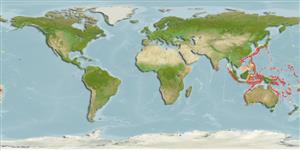>
Perciformes/Scorpaenoidei (Scorpionfishes) >
Peristediidae (Armored searobins or armored gurnards)
Etymology: Satyrichthys: Latin, satyrus = a god or demon, partly human and partly bestial, companion of Bacchus + Greek, ichthys = fish (Ref. 45335).
More on author: Bleeker.
Environment: milieu / climate zone / depth range / distribution range
Ekologi
laut batidemersal; kisaran kedalaman 192 - 420 m (Ref. 93228). Deep-water
East Indo-West Pacific: Japan, East China Sea, Indonesia and Australia.
Size / Weight / umur
Maturity: Lm ? range ? - ? cm
Max length : 48.0 cm SL jantan/; (Ref. 93228)
Life cycle and mating behavior
Maturities | Reproduksi, perkembang biakan | Spawnings | Egg(s) | Fecundities | Larva
Kawai, T., 2013. Revision of the peristediid genus Satyrichthys (Actinopterygii: Teleostei) with the description of a new species, S. milleri sp. nov. Zootaxa 3635(4):419-438. (Ref. 93228)
Status IUCN Red List (Ref. 130435)
ancaman kepada manusia
Harmless
penggunaan manusia
Alat, peralatan
laporan khas
muat turun XML
Sumber internet
Estimates based on models
Preferred temperature (Ref.
123201): 1.8 - 18.7, mean 13 °C (based on 134 cells).
Phylogenetic diversity index (Ref.
82804): PD
50 = 0.5078 [Uniqueness, from 0.5 = low to 2.0 = high].
Bayesian length-weight: a=0.00646 (0.00304 - 0.01372), b=3.08 (2.90 - 3.26), in cm total length, based on LWR estimates for this (Sub)family-body shape (Ref.
93245).
Trophic level (Ref.
69278): 3.6 ±0.3 se; based on size and trophs of closest relatives
Daya lenting (Ref.
120179): Rendah, Waktu penggandaan populasi minimum 4.5 - 14 tahun (Preliminary K or Fecundity.).
Fishing Vulnerability (Ref.
59153): Moderate vulnerability (43 of 100).
